Herrmans H-diver
Tested: From 10 Feb. 2012
Specifications:
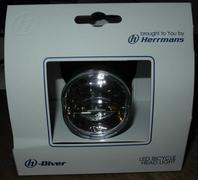
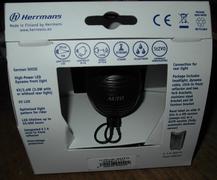
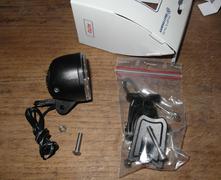
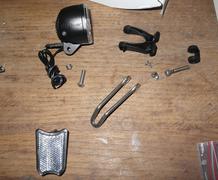
Mass: ca. 42 g for the lamphead with cable, 66g including stainless steel mounting bracket/bolt/nut, and 75 g with the front retro-reflector.
Size: width: ca. 49 mm, height: ca. 53 mm (without protruding piece for the mounting bracket), length ca. 48 mm.
LED:
Mounting width: 12mm (this is not standard), or ca. 22mm with the plastic insert for the mount for a Suntour fork.
On/off: Automatic, but there are versions for standard dynamos (always on).
Standlight: Not on the one I tested, but there is a version with standlight.
Price: ca. € 34,-, version with standlight ca. €40,-, version for sidewall dynamo (always on) ca. €28,-
Pictures:
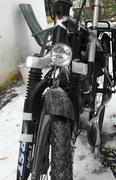
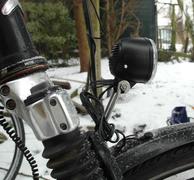
|
Experiences:
The H-diver is similar in shape to the Edelux, and the front clip-on reflector makes the lamp look even more like the Edelux with its additional reflector which to me looks a bit strange, like a farao with beard...
Running it for the first time it's obvious how flickery the light is, much worse than any other dynamo headlamp I tried so far. Up to about 10-11km/h it flickers noticeably on the Shimano HB-NX70 28 pole dynamohub, at least on snow. A few more rides on normal road surfaces and looking at objects such as walls and cars onto which the light shines showed that you will see the flicker until ca. 9 km/h. This is a lot higher than the speeds at which the Edelux/Philips SLD appear flicker free. The lens on the front also lets light go upward directly into your eyes, much worse than the Trelock LS 885 and any of the Philips Saferides. From this you also keep seeing the flicker from the direct light from the lens up to ca. 11 km/h, so covering this up is necessary for that reason too. You see a bright spot coming from direct light from the LED whose position depends on the angle from which you look. Btw., how this works is similar to what happens in Philips' Lumiring taillamp with the view from the side, where this trait is actually useful.
The beam shape is pretty good. Some artefacts near the front wheel, which are not that bad, but it could be better as the large number of artefacts attract your attention on very dark roads. The beam begins not far from the front wheel (ca. 3m). I can see 30-35 m on an unlit road with it. The low lux rating certainly means not much of this lighting up of the road remains (visible) when confronted with a lot of stray light, esp. from headlamps from cars. Herrmans claims a reach of 20m, which could be the case in those situations.
Mounting hardware is all stainless steel, good. There's a separate plastic mount for Suntour forks. The stainless steel mounting bracket: Not great because you can't keep the bolt on the fork crown easily at the end, it tends to go up while tightening. The nuts should be nylock nuts, the one that goes in the plastic mount for suntour forks could be ok, the one for the stainless mount will probably vibrate loose. I used contact glue on the threads to prevent this.
I later tested the reach in case of a dark road with headlamps of cars on a parallel road shining into your eyes (road 4) I would say ca. 25 m.
23-2-2012: I noticed a crack in the top of the lamp. How did this happen? Not from an impact, there are no marks on it. The plastic just cracked. I assume it's a defective sample and dissect it after making a beamshot. I didn't intend to try another such lamp to check for build quality, but I guess I could do it as I will test a new version + a version with standlight (see end of the page for more on this).
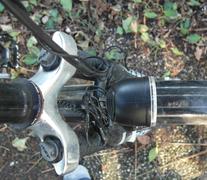
Auto on/off: This is set up quite well with respect to the brightness level at which the lamp goes on. It goes on at dusk and not on cloudy but bright days as my Edelux (the auto on/off of the Edelux is useless for that reason, you might as well leave it on 'ON' instead of auto). There is no delay in on/off which means it has a tendency to go on-off-on etc. at dusk. I even rode at about 20 km/h once and the brightness level was at the edge such that the lamp was flickering at high frequency. Not good. A bright light from the side will immediately switch off the headlamp and I have had this happen once from headlamps of a car on an intersection, very briefly.
Addition 10-3-2012
I was told that the first batch of H-Divers with auto on/off has more flickering at low speeds than what they (Herrmans) would have preferred, and that I probably have a lamp from that first batch. Apparantly they have improved on this considerably. I'll have a look at this newer version and another sample of the version with standlight.
Addition 3-4-2012
I've tested a newer version of the H-diver, this time a version for standard dynamos (always on), and it's less flickery, but still noticeably more flickery than the Edelux or Philips SLD/Saferide 60.
I've also got a version with standlight, I wonder if that's better in this respect due to switching to standlight at low speed.
Addition 8-5-2012
I got into an 'accident' with 2 ducks (yes indeed! :-)) on 2012-5-4: At night, 3 ducks walking on the road, they didn't move out of the way (perhaps the 3rd was a girl-duck they were chasing :)). I didn't spot them soon enough, even though I was not riding fast (about 22 km/h), one crashed into the headlamp while trying to get away the last second.
It made clear: The LED light colour REALLY needs to be neutral white, contrast is poor with cool white which was also a factor in seeing them so late. It was on a parallel road, so cars' headlamps shining in my face from the other road, plus streetlamps. All of this means very little reach of the H-diver with its low lux rating.
Conclusion: Even more so than before, I'm sure that headlamps need to have a throw of 45m or more, and they need a neutral white LED otherwise you can get into these situations.
Addition 16-5-2012
I wanted to install the H-diver with standlight on one of my bicycles when I saw that the lens (which is glued into the housing, which I noticed when I opened up my first H-diver at which time the housing broke in another position...), does not meet the housing at the bottom. The later H-divers I have come from a different source (not the manufacturer btw.) than the first H-diver, so taking this and the housing into account which I think is quite fragile, I am not overly impressed by these headlamps. It seems too much has been saved on the housing and in assembly/quality control.
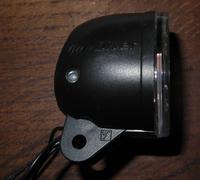
Addition 25-5-2012
Experiences with the H-diver with standlight: Flicker is not less than with the version without standlight.
Standlight strength: experiences to follow.
Beamshots:
For background information on making beamshots see: Camera settings, lamp settings and roads used to make the beamshots.
Beamshots are yet to be made...
Road 2, camera height 1.65m, camera distance: -0.40m, camera aim: 50m on the road.
Herrmans H-Diver |
Lamp height 0.75m
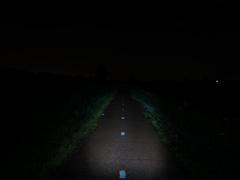
|
Preliminary conclusion:
Beam shape is fairly good, reach is reasonable, comparable to a E3-pro-StvZO, the auto on/off works well (though has a tendency to go on-off-on etc. in the region where it switches on due to the fact it's got a fairly simple system, unlike for example the special dynamo driver which does a lot better). The flicker is awful, perhaps this is better with the version with standlight? There are a fair number of artefacts outside the beam near the bike, which are not too distracting but I'd like to see less of them. It lets a lot of light go to your eyes which is bad, you need to put some black sticky tape on top. Then the crack: Is it just a defect on this lamp or is there a problem with plastic used? I used the lamp in snowy and cold conditions while it was ca. -10°C but any lamp should be able to withstand that without trouble. All in all I'm not so fond of this lamp, it's cheap but also not very good in all respects except beam shape. For a budget buy it's probably one of the best headlamps out there, beating B&M's offerings in price while giving a better and stronger beam than the Cyo R. The H-diver shows that there are useful low priced headlamps, but also that really good headlamps cannot be bought cheaply, which is not to say that the top dynamo headlamps are fault free!
Although for a little while I was thinking that perhaps I was too strict in dismissing low lux rating headlamps (as per my criticism of Philips' 40 lux headlamps for example), due to the experience on 4 May my conclusion is back to what it was: Headlamps that properly illuminate up to about 45m are necesary in rural environments (which means only the Philips Saferide 60, Cyo 60, Edelux and possibly the coming Hermans H-one S), and headlamps with a low lux rating are mainly good for use in the city, but then you may as well use the lowest rating headlamp as you don't need much light there. So, low lux-rating headlamps can be used in rural environments but are not good enough to be really safe.
Last modified: Tue Feb 19 15:48:59 CET 2013








